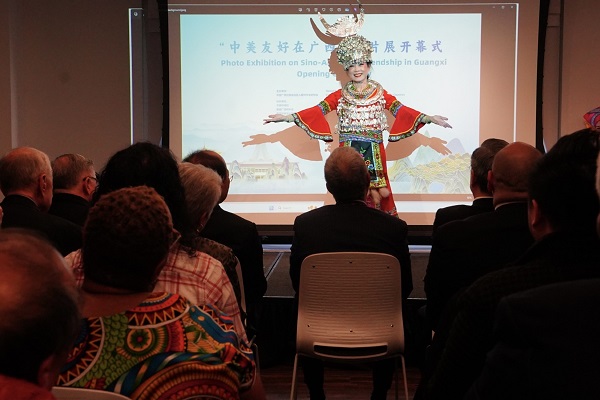Guangxi builds subnational bonds through friendship events

Photo exhibition Sino-American Friendship in Guangxi is launched at the China Institute in New York on Monday. The opening ceremony featured a display that showcased the ethnic diversity in the region, with people wearing traditional attire from their respective groups. MINLU ZHANG / CHINA DAILY
In a move to boost tourism, local governments in China are taking steps to enhance US-China friendship and cooperation from a substate perspective. The local government of Guangxi in Southwest China has launched a series of cultural events in the United States.
In the photo exhibition Sino-American Friendship in Guangxi launched at the China Institute in New York on Monday, Chinese Consul General in New York Huang Ping recalled a time in history when China and the US "joined hands, fighting together for human justice".
About 80 years ago during World War II, the Chinese were fighting against the Japanese invaders and were appreciative of the many American airmen who went to China and fought in the skies against the invaders, Huang said, referring to the Flying Tigers. He said that about 2600 American pilots gave their lives in China.
The Flying Tigers were an American volunteer air squadron based in Guilin, Guangxi, during the initial years of the war.
Hosted by the Guangxi People's Association for Friendship with Foreign Countries, the exhibition's opening ceremony on Monday drew nearly 200 attendees, including representatives from the New York state and city government, and relatives of the Flying Tigers.
"We need to remember, we need to carry on the spirit the Flying Tigers … left as a legacy," said Huang.
The landscape of Guangxi and the United States has a close connection, and Guilin is a place frequented by many foreign dignitaries, including those from the United States, said Guangxi Vice-Governor Liao Pinhu.
"The Flying Tigers fought side by side with the Chinese people in Guangxi to resist the invasion of the Japanese fascists, hence the people of Guangxi are friendly to the American people," said Liao.
Last year, with assistance from the Sino-American Aviation Heritage Foundation, Guangxi and the US signed and launched the "Flying Tiger Friendship Schools and the Flying Tiger Youth Program", a new platform for civil friendship and cooperation, said Liao.
"Guangxi hopes to extend the traditional friendship with the American people, join hands for development and cooperation, and jointly write a new chapter of exchanges and cooperation between China and the US," Liao said.
"At this point, the subnational relationship is one that has the strongest legs and the most positive aspects," said Jan Berris, vice-president of the National Committee on United States-China Relations.
"I think it up to all of us in this room to do whatever we can to help bring back not the life-and-death aspect of the relationship but the focus on the importance of people-to-people relationships, getting to know one another, and realizing that we really have no choice," she said.
Berris, who accompanied the Chinese table-tennis team on its tour of the US in 1972 during the days of Ping-Pong Diplomacy, also suggested travel to Guilin as it stood out as her most cherished journey, not only due to the familial bonds it strengthened but also for the region's hospitality and beauty.
Guangxi is home to 12 ethnic groups: the Zhuang, Han, Yao, Miao, Dong, Mulam, Maonan, Hui, Yi, Jing, Sui and Gelao. The opening ceremony on Monday featured a display that showcased this ethnic diversity, with people wearing traditional attire from their respective groups.














